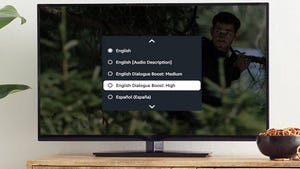
Amazon's Prime Video Makes It Easier to Hear Dialogue Above Background Sounds - CNET
 Why You Can Trust CNET
Why You Can Trust CNET Amazon’s Prime Video Makes It Easier to Hear Dialogue Above Background Sounds
The feature, called Dialogue Boost, is designed with accessibility in mind, but it can be helpful to anyone wanting to adjust their listening experience.
Dialogue Boost helps you hear dialogue above background noises in a TV series or movie on Prime Video.
Amazon
Amazon’s Prime Video is launching a feature called Dialogue Boost, which lets viewers bump up the volume of dialogue relative to background music and effects in a show or movie. The feature is designed for those who are hard of hearing, but anyone can use it to adjust their listening experience if they feel dialogue is being drowned out. Dialogue Boost is initially being rolled out on select Amazon Originals worldwide.
The feature works by analyzing the audio in a show or movie, then identifying parts where it could be hard to hear above background music and effects. It then isolates speech patterns and enhances audio to make that dialogue clearer.
You can turn on Dialogue Boost by going to the audio and subtitle drop down menu while in playback. You can then choose between “English Dialogue Boost: Medium” and “Dialogue Boost: High.” The detail page for a title will show whether Dialogue Boost is available.
The feature is available on all devices that support Prime Video. Amazon Originals that currently support Dialogue Boost in English include titles like The Marvelous Mrs. Maisel, The Big Sick and Being the Ricardos.
“Our library of captioned and audio described content continues to grow, and by leveraging our technological capabilities to create industry-first innovations like Dialogue Boost, we are taking another step to create a more accessible streaming experience,” Raf Soltanovich, VP of technology at Prime Video and Amazon Studios, said in a release.
Amazon is one of many companies looking to boost its accessibility offerings. In February, the e-commerce giant added a feature that lets Amazon Fire TV customers with hearing loss stream audio directly to their hearing implants. It’s also one of the supporting companies for the University of Illinois’ Speech Accessibility Project, which aims to make voice recognition technology more useful for people with a range of diverse speech patterns and disabilities. The initiative is supported by Amazon, Apple, Google, Meta and Microsoft.

